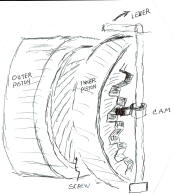

| Scientia ultimas causas Knowledge of ultimate causes Aquinas |
D Vautier
7/23
Just about all cars use disk brakes because they are so easy to maintain and have superior performance. But there is a vast difference between front and rear disk brakes and how they work. This is one reason why manufacturers were slow to adopt rear disk brakes over drum brakes and decided to stay with the tried and true rear drum brake for some time.
Safety laws require that the hand brake (e-brake or parking brake) is totally independent of the hydraulic system so if the hydraulic fails the brake still works. The hand brake usually uses the rear wheels so how were the engineers able to integrate a totally mechanical system into a totally hydraulic system? It was really hard for me to figure that one out.
Here’s how they did it?
 All disk
brakes use a simple piston to drive pads into a rotor. Pretty
simple so far.
All disk
brakes use a simple piston to drive pads into a rotor. Pretty
simple so far.

 But
with back brakes they needed to install a shaft into the back
side of the cylinder. This shaft has a cam on the end of it and a handle
outside the piston. So when the hand brake is pulled it forced the
cam against the piston locking the rotor. Still pretty simple so far. Right? Wrong.
But
with back brakes they needed to install a shaft into the back
side of the cylinder. This shaft has a cam on the end of it and a handle
outside the piston. So when the hand brake is pulled it forced the
cam against the piston locking the rotor. Still pretty simple so far. Right? Wrong.
 As brake pads ware out the piston
moves outward away from the cam which causes the hand brake to be unable to
contact the piston. The
problem was solved by “growing” the piston so to speak.
As brake pads ware out the piston
moves outward away from the cam which causes the hand brake to be unable to
contact the piston. The
problem was solved by “growing” the piston so to speak.
Engineers built a piston that “grows” by
dividing it into two sections, a face and a screw assembly that can rotate.

 As the hand brake
moves to lock the wheels, it presses against a series of groves or ratchets on the surface
of the back plate of the screw part of the piston. Because of brake pad ware, every so
often the cam lands just behind a notch so when the hand brake is set the
cam imparts a twist to the screw thus “growing” the piston a little bit. The
other part of the piston does not turn because it is sort of locked to the brake
pad and seal.
As the hand brake
moves to lock the wheels, it presses against a series of groves or ratchets on the surface
of the back plate of the screw part of the piston. Because of brake pad ware, every so
often the cam lands just behind a notch so when the hand brake is set the
cam imparts a twist to the screw thus “growing” the piston a little bit. The
other part of the piston does not turn because it is sort of locked to the brake
pad and seal.
The big implication of all this is brake pad replacement which has always been a simple task. The piston is simply pushed in and new pad are installed. Not at all so with rear brake pistons anymore which must be counter-intuitively screwed back into the cylinder.